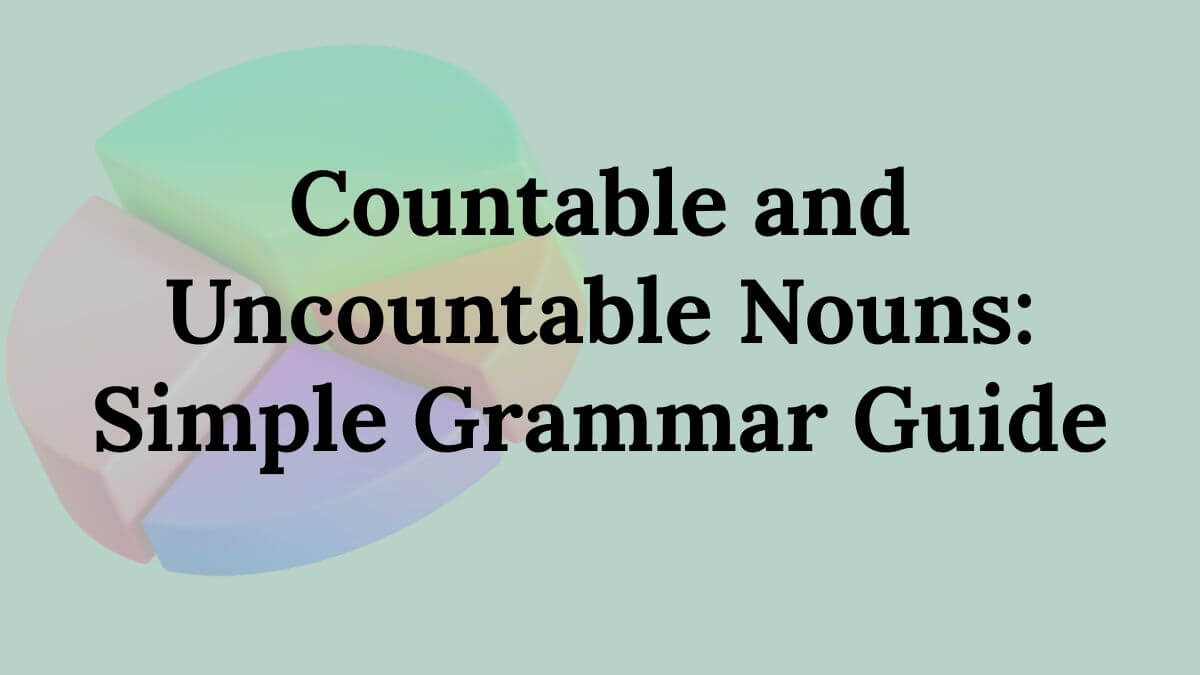Knowing countable and uncountable nouns is key to mastering English grammar. Whether you’re learning English or teaching it, grasping how to use these nouns correctly will improve your writing and speaking skills.
In this simple grammar guide, we’ll explore what countable and uncountable nouns are, how to identify them, and common rules for using them. Let’s dive in!
What Are Countable and Uncountable Nouns?
Before we jump into the details, let’s clarify what countable and uncountable nouns mean. These terms describe how we classify nouns based on whether they can be counted as individual units or not.
- Countable nouns are things you can count, like “one apple,” “two apples,” or “three apples.”
- Uncountable nouns are things you can’t count individually, like “water,” “rice,” or “information.”
This distinction is important because it affects how we use articles, quantifiers, and verbs with these nouns.
Why Is Understanding Countable and Uncountable Nouns Important?
Using countable and uncountable nouns correctly helps you form grammatically accurate sentences. For example, saying “many water” is incorrect because water is uncountable. Instead, you say “much water” or “a glass of water.”
Understanding these nouns also aids in choosing the right determiners like some, any, a few, or much, making your communication clearer and more natural.
Identifying Countable Nouns
What Makes a Noun Countable?
Countable nouns are individual objects, people, animals, or things that can be separated and counted.
Examples of Countable Nouns:
- Books
- Chairs
- Dogs
- Apples
- Cars
How to Use Countable Nouns Correctly
- Use numbers directly: two dogs, five books.
- Use “a” or “an” with singular countable nouns, like a chair or an apple.
- Plural forms usually end in -s or -es: cats, boxes.
Quantifiers with Countable Nouns
Common quantifiers include:
- Many: “There are many students in the class.”
- A few: “I have a few friends coming over.”
- Several: “She bought several dresses.”
Understanding Uncountable Nouns
What Makes a Noun Uncountable?
Uncountable nouns refer to things that cannot be divided into separate elements or counted individually.
Common Types of Uncountable Nouns:
- Substances: water, milk, bread
- Abstract ideas: information, advice, knowledge
- Natural phenomena: rain, snow, wind
How to Use Uncountable Nouns Correctly
- Uncountable nouns usually don’t have a plural form.
- Use quantifiers like much, some, or a little: “There is much noise outside,” or “I need some information.”
- To specify quantity, use measurements or containers: “a cup of tea,” “a piece of advice.”
Quantifiers with Uncountable Nouns
Some common quantifiers are:
- Much: “How much sugar do you want?”
- Use “a little” with uncountable nouns: “Can I have a little milk in my coffee?”
- Some: “She gave me some help.”
Special Cases: Nouns That Can Be Both Countable and Uncountable
Examples:
- “Hair”
- Countable: “I found three hairs on my shirt.”
- Uncountable: “Her hair is very long.”
- “Time”
- Countable: “I have been there three times.”
- Uncountable: “Time flies when you are having fun.”
- “Light”
- Countable: “There are many lights in the room.”
- Uncountable: “We need more light here.”
Common Mistakes to Avoid
- Using plural forms with uncountable nouns:
- information’s → ✅ information
- Using “many” with uncountable nouns:
many advice → ✅ much advice - Forgetting articles with singular countable nouns:
I have dog → ✅ I have a dog
Quick Tips to Remember
- If you can add a number before a noun, it’s probably countable.
- If it’s a substance, concept, or mass you can’t separate, it’s likely uncountable.
- Use appropriate quantifiers to match the noun type.
- When in doubt, check if the noun has a plural form in standard English usage.
Practice Examples
Sentence |
Correct or Incorrect? |
Explanation |
| I have two books. | Correct | Books is countable and plural here. |
| Can I have some water? | Correct | Water is uncountable, use some. |
| She gave me many information. | Incorrect | Information is uncountable, use much. |
| There are several chairs. | Correct | Chairs is countable and plural here. |
Read More:
Singular and Plural Nouns: Rules You Must Know
7 Common Mistakes with Auxiliary and Modal Verbs – And How to Fix Them!
Conclusion
Mastering countable and uncountable nouns is a fundamental step in improving your English grammar. Knowing how to identify and use these nouns correctly will help you construct clearer sentences and communicate more confidently
Remember: countable nouns can be counted and have plural forms, while uncountable nouns refer to things that can’t be counted individually and usually don’t have plural forms.
